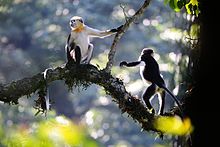Tonkin snub-nosed monkey
| Tonkin snub-nosed monkey | |
|---|---|
 |
|
| Scientific classification | |
| Kingdom: | Animalia |
| Phylum: | Chordata |
| Class: | Mammalia |
| Order: | Primates |
| Family: | Cercopithecidae |
| Genus: | Rhinopithecus |
| Species: | R. avunculus |
| Binomial name | |
|
Rhinopithecus avunculus (Dollman, 1912) |
|
 |
|
| Tonkin snub-nosed langur range | |
The Tonkin snub-nosed monkey or Dollman's snub-nosed monkey (Rhinopithecus avunculus) is a slender-bodied arboreal Old World monkey, endemic to northern Vietnam. It is a black and white monkey with a pink nose and lips and blue patches round the eyes. It is found at altitudes of 200 to 1,200 m (700 to 3,900 ft) on fragmentary patches of forest on craggy limestone areas. First described in 1912, the monkey was rediscovered in 1990 but is exceedingly rare. In 2008, fewer than 250 individuals were thought to exist, and the species was the subject of intense conservation effort. The main threats faced by these monkeys are habitat loss and hunting, and the International Union for Conservation of Nature has rated the species as "critically endangered".
The Tonkin snub-nosed monkey has a flattened face with a pink upturned nose, thickened pink lips and areas of blue skin around its eyes. The upper parts are black, the underparts creamy-white and there is an orange patch on the throat, particularly obvious in breeding males. The tail has a white tip. Its head-and-body length is 51 to 65 cm (20 to 26 in) and its tail 66 to 92 cm (26 to 36 in). Females weigh about 8 kg (18 lb) while males weigh 14 kg (31 lb). Juveniles are grey rather than black and lack the orange throat patch.
The Tonkin snub-nosed monkey is diurnal and its diet consists of a range of leaves, fruits, flowers and seeds. It moves about the canopy in small groups.
Recorded at elevations between 200 and 1,200 m, its distribution is currently restricted to small fragmented tropical evergreen forests associated with steep karst limestone hills and mountains. Five isolated extant populations have been identified since its rediscovery. Despite being heralded as a flagship species and subsequently receiving international attention and conservation actions, the population trend is still declining; therefore causing it to be continuously listed as one of "The World's 25 Most Endangered Primates." since the first global non-human primate biennial assessment began in 2001.
Habitat loss and hunting are some of the major causes for declines of naturally occurring populations of non-human primates, including the Tonkin Snub-nosed monkey. Decades of expanding human population and increasing demands for scarce agriculturally viable lands have led to the loss and fragmentation of the monkey's habitats. However, habitats of known Tonkin snub-nosed monkey populations were long lost and fragmented prior to their rediscovery. A pioneering study in 1993, in Na Hang Nature Reserve, obtained a population count of 72 individuals (estimated 80), and a subsequent study at the same site in 2005 obtained a population count of 17 individuals (estimated 22). Evidenced by both primary and secondary data, the population decline within that 13-year period can only be attributed to hunting activities.
...
Wikipedia

